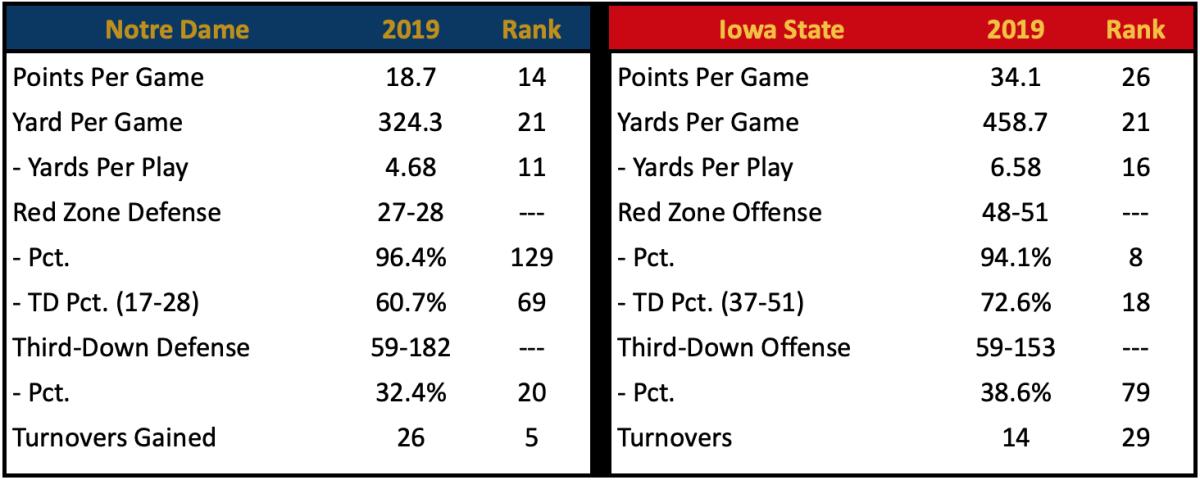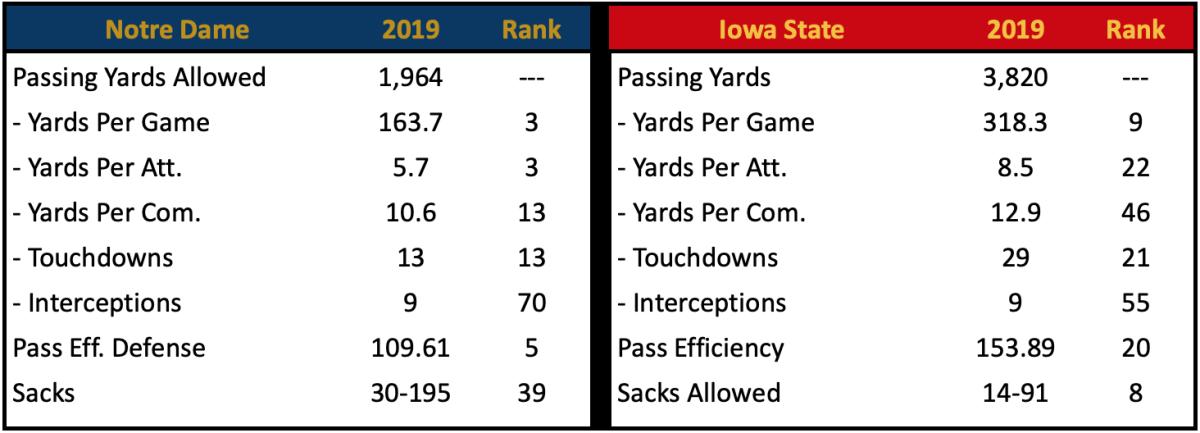Stacking Up: Notre Dame Defense vs. Iowa State Offense

Notre Dame (10-2) faces Iowa State (7-5) in the Camping World Bowl. The Cyclones record is a bit misleading, as four of those five losses came by a combined 11 points to four ranked opponents.
Notre Dame and Iowa State on paper presents a very intriguing matchup.
NOTRE DAME SCORING DEFENSE vs. IOWA STATE SCORING OFFENSE

Advantage: Notre Dame
I give Notre Dame the advantage, but it’s not my much. This is going to be a contest of one of the nation’s best defenses against one of the nation’s best offenses. Iowa State ranks 18th nationally in offensive efficiency according to the Fremeau Efficiency Index, and Notre Dame ranks 8th in defensive efficiency.
Notre Dame ranks in the Top 25 nationally in scoring defense, total defense, yards allowed per play, third-down defense and turnovers gained. The team’s points allowed per game average is almost identical to last fall (18.7 in 2019 to 18.2 to 2018), but Notre Dame saw a jump in total defense, third-down defense and yards allowed per play.
The Irish had back-to-back rough games against USC and Michigan, giving up an average of 37.5 points, 431.5 yards and 6.1 yards per play in those games, which the Irish split. In its other ten games, Notre Dame gave up just 14.9 points per game, 302.8 yards and 4.4 yards per play.
Notre Dame was especially good in November, giving up just 14.2 defensive points per game, 275.4 yards per game and 4.03 yards per play despite playing a pair of Top 50 offenses (Navy, Boston College).
Iowa State’s scoring average is boosted by a 72-point, 714-yard performance against Louisiana-Monroe, but it doesn’t completely take away from how good the unit has been for much of the season despite having a sophomore quarterback and a freshman running back. Iowa State has racked up at least 405 yards of offense in 10 of its 12 games.
The Cyclones ranks in the Top 30 offensively in scoring offense, total offense, yards per play and turnover margin.
Iowa State ranks just 79th in third-down offense, with its offensive production being due mostly to being an explosive, big-play group. Iowa State ranks 11th nationally in explosive plays (FEI), which will make the matchup against Notre Dame even more intriguing. Notre Dame ranks 9th nationally in limiting explosive plays.
Iowa State averaged 442.0 yards and 6.22 yards per play in its four games against Top 25 opponents, but scored just 26.5 points in those contests, all defeats.
The reason was seven of Iowa State’s nine turnovers during the season came in those games. The one game against a Top 25 opponent that Iowa State did not turn it over was the Oklahoma game, and it’s not a coincidence the Cyclones scored 41 points in that contest.
Notre Dame ranks fifth in the nation in turnovers gained.
The advantage for Iowa State is that it was highly effective when it got into the red zone, ranking 8th in red zone percentage and 18th in red zone touchdown percentage. Notre Dame’s defense ranks 129th (out of 130 teams) in red zone defense and 69th in red zone touchdown defense.
NOTRE DAME RUSH DEFENSE vs. IOWA STATE RUSH OFFENSE

Advantage: Notre Dame
From a pure statistical standpoint this matchup is relatively even, with Notre Dame holding a slight advantage. When you dive a bit deeper into the numbers you see the Irish have a significant on paper advantage.
Notre Dame’s overall numbers aren’t great, with the Irish ranking 71st nationally in yards allowed per game. The defense was up-and-down for much of the season, giving up a lot of yards early and then shutting down teams in the middle of the season before back-to-back poor performances against USC and Michigan.
Since then, Notre Dame has been a highly effective rush defense. Note Dame held Virginia Tech and Duke below 100 yards on the ground, and Stanford rushed for only 118 yards. Navy went for 281 yards, which at the time was over 70 yards below its season average, and Boston College’s 128 yards was 154 yards below its season average going into that game.
Most of that happened with Notre Dame not being 100-percent, as standout end Julian Okwara joined fellow end Daelin Hayes on the season-ending injured list in the Duke game. The Irish also didn’t have standout sophomore defensive tackle Jayson Ademilola in the final two games, but the defense still played stout run defense down the stretch.
Notre Dame’s final five opponents averaged just 3.6 yards per rush in the final five games of the season.
Iowa State’s numbers aren’t overly impressive either, and they can’t bank on a strong finish like Notre Dame did. The Cyclones rushed for 270 yards against a Louisiana-Monroe offense that ranks 128th in rush defense. In its other 11 games, Iowa State averaged just 128.5 yards and 4.1 yards per rush in its other 11 games.
Iowa State racked up 195 yards (5.1 YPC) in a 42-41 loss to Oklahoma, but it averaged just 93.3 rushing yards and 3.15 yards per attempt in the final three games of the season.
Freshman running back Breece Hall was the lone bright spot for the Iowa State ground game, earning Pro Football Focus Freshman All-American honors after rushing for 842 yards and nine touchdowns while rushing for 5.0 yards per attempt. He had four games with at least 101 yards in the final seven games of the season.
NOTRE DAME PASS DEFENSE vs. IOWA STATE PASS OFFENSE

Advantage: Notre Dame
This is the most intriguing matchup of the game for me, Notre Dame’s highly regarded pass defense against Iowa State’s explosive pass offense.
On paper it’s tightly contested, but Notre Dame has the edge. Iowa State, however, has a pass system and the talent to threaten the Irish defense.
There aren’t the high-end NFL talents at wide receiver that Notre Dame faced against USC, but the quality of depth at wide receiver and the talent at tight end reminds me a great deal of what Virginia Tech brought to the matchup against the Irish.
One big difference, however, is that Iowa State quarterback Brock Purdy is a far, far better passer than Hokie quarterback Quincy Patterson.
Purdy has been tested this season, and he’s played well in the biggest games. The sophomore played four Top 50 pass defenses, and Purdy completed 65.3-percent of his throws in those games and had a 160.90 pass efficiency rating. Purdy threw nine touchdowns in those contests and was not picked off once.
Four different Iowa State players caught at least 33 passes and racked up at least 622 receiving yards this season. Senior Deshaunte Jones is the chain mover, sophomore Tarique Milton is the big-play threat, senior La’Michael Pettway brings the size and Charlie Kolar is one of the most productive tight ends in the country.
That group will provide the Notre Dame defense with a major test, but it won’t be their first big test of the season.
Notre Dame ranks in the Top 5 nationally in passing yards allowed, yards allowed per attempt and pass efficiency defense. It also ranks 13th in yards allowed per completion, 13th in touchdowns allowed and ranked 39th in sacks.
The Irish have a deep cornerback rotation, and the unit has unique traits, which should help it matchup against the Cyclones. Notre Dame also has a talented trio at safety, which also presents it with the ability to matchup against Iowa State, especially Kolar at tight end.
Veteran safeties Alohi Glman and Jalen Elliott will get a chance to finish their careers with strong games against a talented pass offense.
Follow me on Twitter: @CoachD178
Visit our Facebook page at: https://www.facebook.com/IrishMaven/
